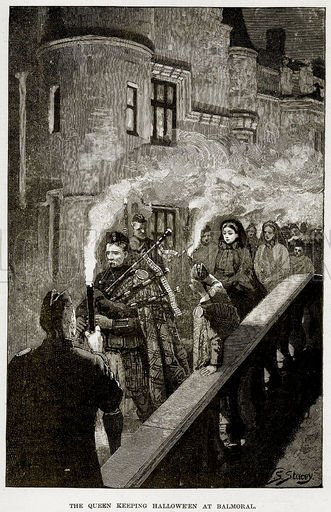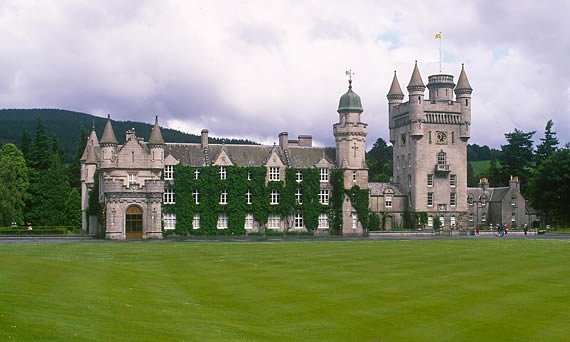From Ruth Edna Kelley’s The Book of Halloween, a description of a Victorian Halloween:
In 1874, at Balmoral, a royal celebration of Hallowe’en was recorded. Royalty, tenants, and servants bore torches through the grounds and round the estates. In front of the castle was a heap of stuff saved for the occasion. The torches were thrown on. When the fire was burning its liveliest, a hobgoblin appeared, drawing in a car the figure of a witch, surrounded by fairies carrying lances. The people formed a circle about the fire, and the witch was tossed in. Then there were dances to the music of bag-pipes. – from Chapter VIII
And from the London Times:
“Halloween at Balmoral Castle. – This time-honoured festival was duly celebrated at Balmoral Castle on Saturday evening in a manner not soon to be forgotten by those who took part in its enjoyments.
“As the shades of evening were closing in upon the Strath, numbers of torch-lights were observed approaching the Castle, both from the cottages on the eastern portion of the estate and also those on the west. The torches from the western side were probably the more numerous, and as the different groups gathered together the effect was very fine. Both parties met in front of the Castle, the torch-bearers numbering nearly 100.
“Along with those bearing the torches were a great many people belonging to the neighbourhood. Dancing was commenced by the torch-bearers dancing a “Hulachau” in fine style to the lilting strains of Mr. Ross, the Queen’s Piper. The effect was greatly heightened by the display of bright lights of various colours from the top of the staircase of the tower. After dancing for some time the torch-bearers proceeded round the Castle in martial order, and as they were proceeding down the granite staircase at the north-west corner of the Castle the procession presented a singularly beautiful and romantic appearance.
“Having made the circuit of the Castle, the remainder of the torches were thrown in a pile at the south-west corner, thus forming a large bonfire, which was speedily augmented with other combustibles until it formed a burning mass of huge proportions, round which dancing was spiritedly carried on. The scene at this juncture was one to be long remembered by those who witnessed it. The flames of the bonfire shot up to an immense height, illuminating the Castle wall with a ruddy glare, while the figures of the dancers in their agile and grotesque movements were shown to great advantage.
“Her Majesty witnessed the proceedings with apparent interest for some time, and the company enjoyed themselves none the less heartily on that account.”


